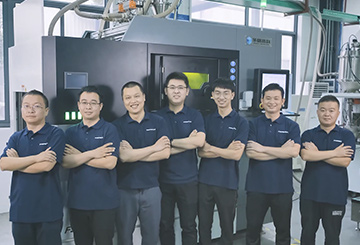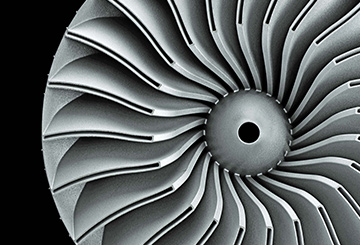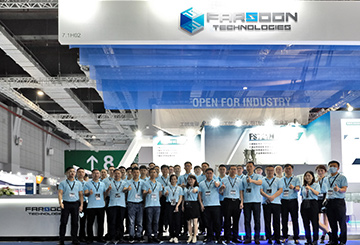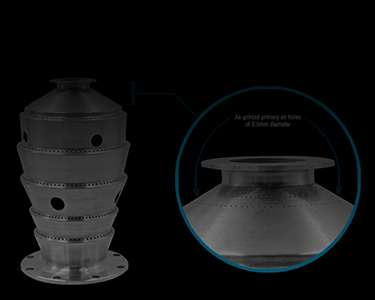Background:
Referred to as the “heart” of a turbine-engine, the combustion chamber is responsible for the critical task of burning large quantities of fuel, with extensive volumes of the air, to generate heat and a smooth stream of uniform gas flow that is required by the turbine for nominal operation.
A flame tube —- the subject of this article, is spaced apart from the combustion chamber housing along the central axis of the turbine-engine. Designed with multiple intake holes, the flame tube creates the super-heated gas that rapidly brings the injected fuel to ignition temperature.
Being a key component of the combustion chamber, the flame tube has to withstand extreme conditions of heat and pressure, while achieving the required reliability and efficiency. As a leading expert in design and manufacturing of engine combustion chambers and fuel injection system for the aerospace and shipping industry in China, Chengli Aviation uses Farsoon metal additive technology for the development of flame tubes with improved durability and weight optimization.
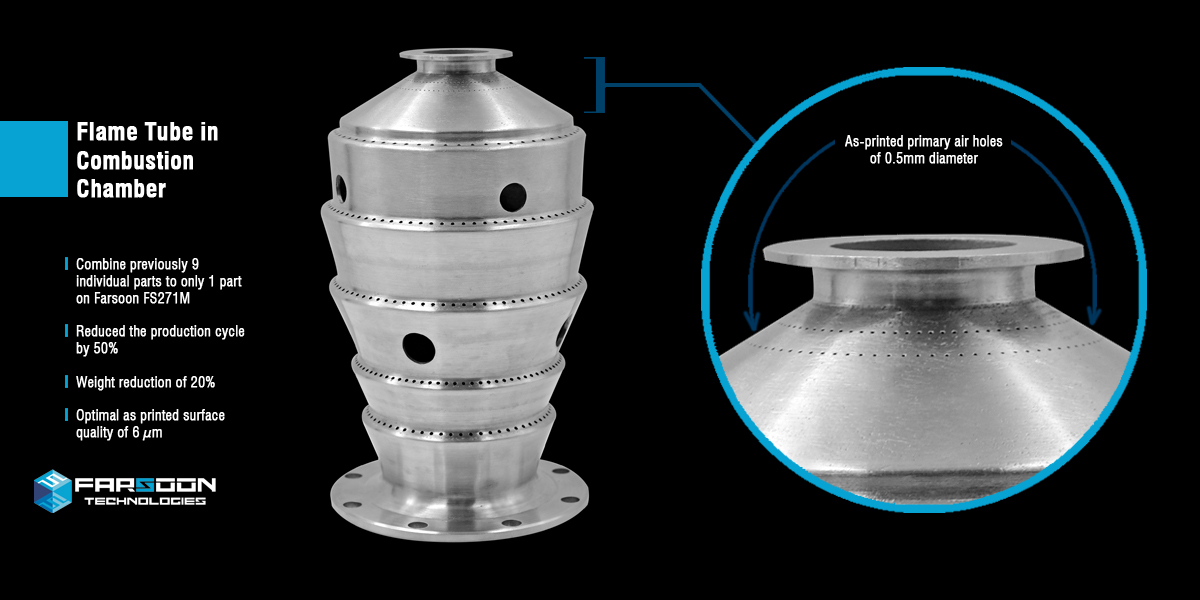
(Figure 1) Additive manufactured flame tube in combustion chamber. Design by Chengli Aviation, produced on Farsoon FS271M. Image courtesy: Farsoon Technologies
Challenge:
Reliability is a critical consideration in flame tube design. With extreme operational conditions including high temperature, corroding heat releasing gases, and turbulent pulsating airflow, the flame tube is subject to thermal stress that often generates failures including cracks, ablation, flaking, deformation, etc. Under such extreme working conditions, the flame tube is designed with complex structures to achieve the required strength and functionality. These structures including colanders, primary zone, flame tube body, air holes and gas discharge are all extremely difficult to manufacture with traditional means. Furthermore, the flame tube wall is designated with hundreds of varies sized features including primary air holes, secondary air holes and dilution air holes. These complex structure and features result in a part design that is difficult manufacture using traditional techniques. The flame tube has to be manufactured as separate parts then joined via multiple cutting, bending and welding processes.
The complexity of the manufacturing is extremely challenging and heavily influences the reliability of the finished part, as the assembled parts increased the potential for damage during operations, resulting in a higher rejection rate. Furthermore, the assembly makes it difficult for precision size control of the product, which is key to achieving combustion efficiency and airflow pattern stability. In addition, the multiple machining and assembly processes results slow design iteration during development and long manufacturing cycles.
Best suited solution for application:
In early 2017, Chengli Aviation adopted Farsoon Metal Additive Manufacturing to meet the challenges in the design and manufacturing process of aerospace engine components. Farsoon’s open metal additive system offers unprecedented freedom for design geometry and tuning of processing parameters that best suits the application of the flame tube (Figure 1).
GH3536 (UNS Number N06002), a nickel-based high-temperature alloy widely used in aerospace turbine combustion chamber components, is used for this application. Featuring excellent oxidation and corrosion resistance, good processability and welding performance, the as-printed GH3536 on Farsoon metal system can achieve a variety of performance characteristics through different heat treatment processes. Being an early aerospace adopter of additive technology in China, Chengli Aviation uses their Farsoon FS271M to collaborate with Farsoon in the development of processing parameter of GH3536 to achieve the required performance, heat treatment and surface quality for their specific application. Thanks to Farsoon’s open material and parameter strategy, Chengli Aviation is able to further tune their system for specialized materials and processing parameters as their application range expands.
Result:
The additively optimized design of the flame tube is able to combine previously 9 individual parts to only 1 part, and produced by Farsoon FS271M in a single piece. It simplified the complexity of traditional manufacturing and assembly process and reduced the production cycle by 50%, while enhancing the structural integrity, size precision and success rate of the production by eliminating the manual welding of joints. The post processed flame tube has passed functional tests under working conditions with high temperature reliability.
Moreover, the additively produced flame tube achieved a weight reduction of 20% compared to the original process, with the same designated strength requirements. The lighter weight of key combustion components means increased efficiency and flying distances and aircraft carrying weight. In addition, the lightweight design improves combustion fuel efficiency, helping with atmospheric pollution.
Thanks to Farsoon’s advanced scanning strategy, the as-built flame tube can achieve optimal as printed surface quality of 6 μm resulting in less requirements for post processing. Features such as primary air holes of 0.5mm diameter can be achieved. The part was also additively designed with minimal support structure required which aids the improved surface quality.
“We have full confidence working with Farsoon additive technology and service,” Says Chengli Aviation, “We are keep receiving huge benefits using Farsoon’s open platform machines, where our engineers can have full access to explore a variety of configurations for the applications. Our team now has actively used multiple Farsoon systems for a wide range of projects and components from design-prototyping, small batch production to certifications, including Fuel nozzles, injection fuel rings, main fuels, combustion chamber components, turbine blades, engine impeller, swirlers, etc.”
About Farsoon:
Farsoon Technologies, founded in 2009 by Dr. Xu Xiaoshu, one of the early pioneers of laser sintering technology with more than 20 years’ experience in the industry, now is a leading machine supplier of industrial Metal Laser Melting and Plastic Laser Sintering systems. Farsoon has developed a team of world-class experts with competencies in electrical/mechanical engineering, laser, scanning and optics, thermal controls, as well as material development and applications engineering. With clear vision “Open for Industry”, Farsoon is committed to supporting the industrial production with open systems, materials, parameters and applications. For more information, please visit: www.farsoon.com
About Chengli Aviation:
Chengli Aviation is the leading enterprise specializing in the design, development and production of engine combustion chambers and fuel injection systems for aviation, aerospace and shipping industry. Enjoying a solid background in both traditional manufacturing solutions and additive technology, Chengli Aviation is able to supply product of unparalleled quality and innovation to the market.
Author: Chenlu Fang, Global Marketing Manager, Farsoon Technologies
Contact: globalinfo@farsoon.com
Website: www.farsoon.com
DOWNLOAD SUCCESS STORY

